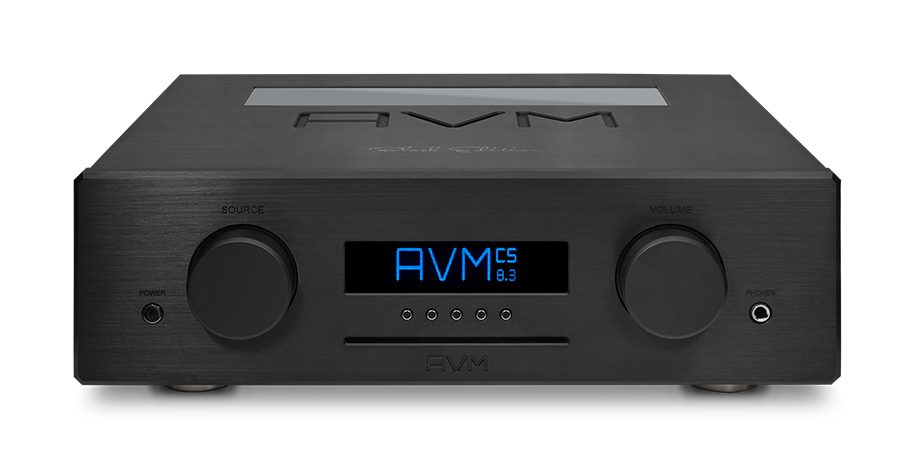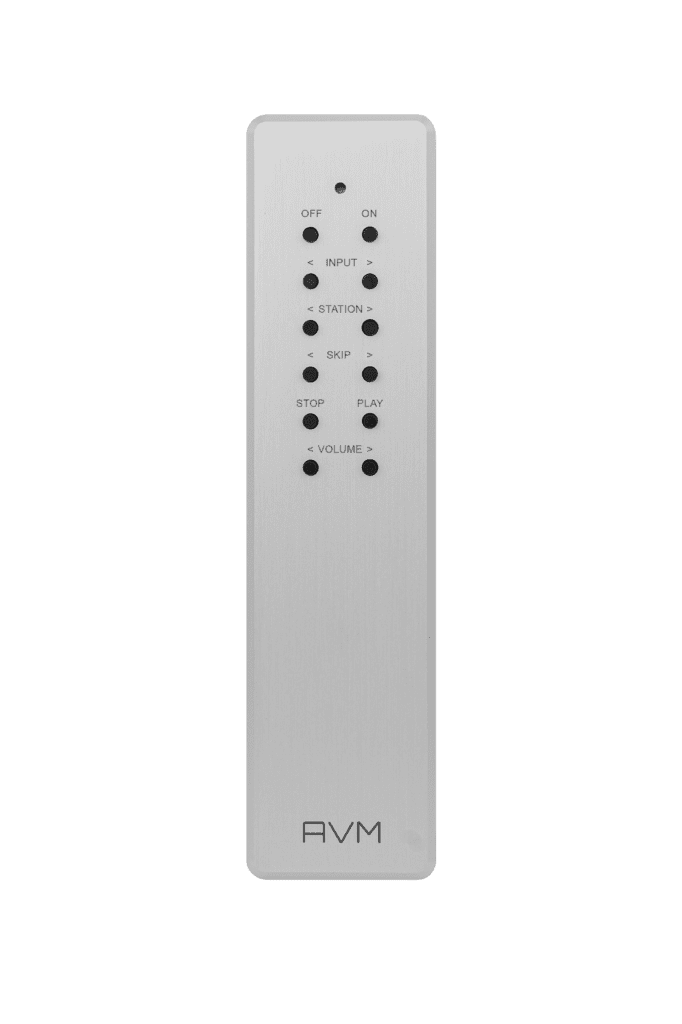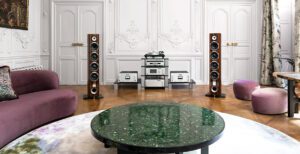
High end audio is at something of a crossroads today. I don’t mean that it will have to make a pact with the devil if it wants to succeed; that happened years ago. No I’m talking about the domestic acceptability of multi-box systems. There was a time not so long ago when you had to have at least half a dozen ‘hewn from solid’ aluminium facias staring out from a serious looking rack if you wanted to hold your head high among the cognoscenti. Nowadays things aren’t so clear, and many brands including those in the high-end are making one or two box systems that perform as well and offer the same features as the stacks of racks alternative.
Power without mass
AVM covers both markets with a broad range of separate and integrated electronics as well as turntables, they still warrant their own box, for now. The Ovation CS 8.3 is AVM’s top all in one streamer, DAC, CD player and amplifier package, it has all the popular bases covered; those wanting to spin their wax will need to add a phono stage. There are more than a few streamer/DAC/amps on the market but the presence of a CD drive elevates the CS 8.3 into less densely packed terrain. Then there’s the fact that the amplifier has a specified output of 500 Watts. It doesn’t look like a muscle amp and doesn’t weigh in at that sort of poundage but by using a switching power supply AVM has managed to give the CS 8.3 serious power.
What differentiates this model from the near identical looking CS 6.3 is the presence of a valve line stage, the thermionic devices being displayed in the top of the case under a glass cover. The DAC section, which has most of the usual in- and outputs, is built around a set of four ESS Sabre chips that are capable of converting signals up to 32-bit/384kHz PCM and DSD 128. Useful in a ‘rather tricky to upgrade single box’ design, the DAC is modular, that is it can be replaced with an updated version when technology moves on. The X-Stream streaming engine is ready to be upgraded via firmware, and given that this unit sits on the network that should be fairly straightforward to achieve.

The amplifier technology appears to be up to the moment and thus should not need upgrading in the foreseeable future. Ditto the TEAC CD drive, which being a legacy format is unlikely to see any changes. The only issue with keeping discs spinning is drive reliability and here I would expect AVM to have the requisite transports ready for replacement. The aluminium casework is cleverly assembled without visible fixings and hides a carefully separated interior. Here you will find what AVM describe as a ‘Chinese Wall’, a mechanical partition that shields the signal carrying electronics from the high frequency radiations of the power supply.
Gruyere
The CS 8.3 Black Edition is not merely a black anodised version but an upgrade on the standard model with a premium price. The extra money buys special grade valves with a life expectancy of over 20,000 hours. AVM doesn’t specify the brand of valve or even the type but they appear to be double triode types a la ECC83 or similar. Valve quality varies about as much as that of cheese so having better ones is undoubtedly beneficial, unless you like your cheese processed of course. That’s not all you get, the digital to analogue converters are hand picked, which usually means that all the chipsets are measured and those with the finest tolerances are kept for the top flight products. When you have four DACs working together, or two pairs at least, the closer their match the better the end result. Apparently the power supply for these converters is also more refined in the Black Edition.
Connections extend to analogue in- and outputs on XLR and RCA sockets, optical, coaxial and USB digital inputs as well as network connections over wi-fi or ethernet. The speaker cable terminals are nice WBT types with minimal metalwork for better sound.
Control
AVM has its own streaming app, which means that you don’t need the optional remote control but that said when you’re using inputs other than the streamer it’s quicker and easier to use a handset. The volume slider on the app works well and offers fine control however, as does the app overall, it natively accesses Qobuz, Tidal, Highresaudio and Spotify and has a good selection of net radio stations with a search facility that makes tracking down favourites painless. It also allows input selection for mechanical and wireless connections including Airplay and Bluetooth.
The sonic character of the CS 8.3 is largely dominated by its Class D amplifier, the presence of valves in the equation brings a refinement and transparency to the result no doubt but the lightness of touch, speed and clean power without the usual Class AB distortion characteristics are what distinguish it. This is top notch Class D, like the aforementioned comestibles these things come in an ever increasing variety of types, from the slightly hollow to the rather too explicit sounding. This AVM is very well judged indeed; the music it produces bears little if any imprint of the amplification technology. High power amplifiers usually have a strong sense of grip, this can sound nice and gives you a sense of the muscle available, but this is essentially the character of the amplifier being imprinted on the music. Other big amps produce a thick, solid sound that is also appealing but again this is a form of masking, the technology is not transparent to the signal.
The absence of certain forms of distortion means that volume perception is different, there is no compression or loudness as the level increases which means that you can end up playing at higher volumes than is healthy for neighbourly relations, but boy is it fun, especially when the music has been well captured. I put it to someone who knows what goes on in the pro audio world that in order for end users to get the same sound that the artist hears in the studio, or the audience at a concert, they should be using the same amplification type. Adding that as Class D has taken over in both studios and PA this is why decent current recordings of recent years sound so good with Class D at home. He is of the opinion that yes this is a factor but that it’s not as big a factor as the quality of digital electronics used to make the recordings. It’s here that things have come on dramatically in the last couple of decades and the cleaner our systems are at home the more we hear it.

Suffice to say the AVM is very clean indeed which can be a way of saying that it’s clinical and lacks heart and soul. I’m happy to report that this is definitely not the case, there were several occasions when a piece of music brought a lump to my throat, not least the allegedly ‘unknown’ Bonnie Raitt’s ‘Too Long at the Fair’ [Give it Up]. This is a recent discovery but not one that hits home regardless of hardware, it can easily sound like a great song without the emotional impact that a good system can reveal. At the other end of the scale Rymden’s live ‘Pitter Patter’ [Space Sailors] developed so much scale and dynamic power that it was like sitting in the best seat at the concert.
The above experiences were delivered by the streamer but I spent some time with other inputs too, CD is a little sharper, smaller and flatter sounding but it has good leading edge definition and something about the more forward balance suggested it could be what was originally intended. That being Herbie Hancock’s piano in sharp focus on a Hancock album, the stream makes this piece seem more of an ensemble production. Switching to Qobuz from CD made a good case for the silver disc, which timed better and while being a little harder in tonal terms had better flow. I also tried the analogue inputs with a turntable and phono stage, the result here was also excellent, making less obvious material accessible and providing high transparency to the signal.
AVM has done an excellent job with the CS 8.3 Black Edition, it would hold its own against separates of the same overall value and quite likely beat all but the best of them. If other brands can get sources and amplification of this calibre into one box I see a bright future for the pared down high end system.
Technical specifications
- Type Hybrid 2-channel integrated amplifier with built-in streamer, DAC, CD player and headphone amplifier
- Analogue inputs One single-ended line-level input (via RCA jacks), one balanced input (via XLR connectors)
- Digital inputs Three S/PDIF (one coaxial, two optical), one USB port
- Analogue outputs One single-ended line-level input (via RCA jacks), one balanced input (via XLR connectors)
- Digital outputs Two S/PDIF (one coaxial, one optical).
- Supported sample rates
Coaxial and optical S/PDIF 16-bit, 24-bit — 32kHz – 96kHz – 192kHz
USB 16-bit, 24-bit, 32-bit — 32kHz – 192kHz – 384kHz, DSD64 — DSD128 — DSD256 - Input impedance Not specified
- Output impedance (preamp) Not specified
- Headphone Loads Not specified
- Power Output 500Wpc @ 4 Ohms
- Bandwidth Not specified
- Distortion Not specified
- Signal to Noise Ratio Not specified
- Dimensions (H×W×D) 130 × 430 × 355mm
- Weight 13kg
- Price £15,950
Manufacturer
AVM Audio Video Manufaktur GmbH
UK distributor
PMC UK Distribution
+44 (0)1767 686 300
By Jason Kennedy
More articles from this authorRead Next From Review
See all
PrimaLuna EVO 100 phono preamplifier
- Apr 22, 2024

Reiki Audio SuperSwitch Master Pro + Servant Pro
- Mar 27, 2024

Melco Audio N1-S38 music server
- Mar 27, 2024











